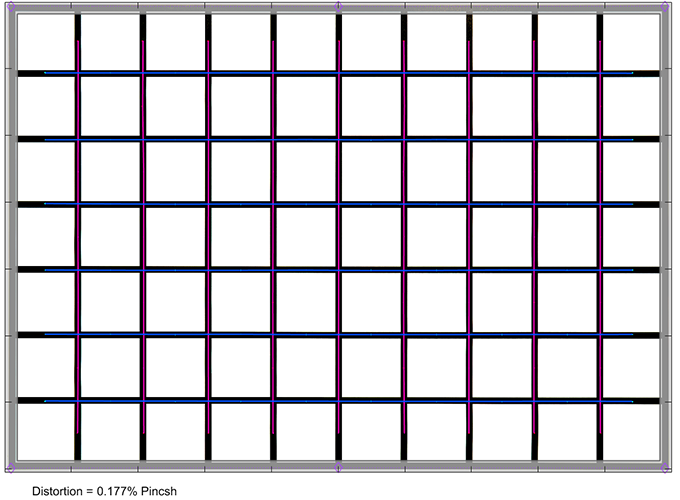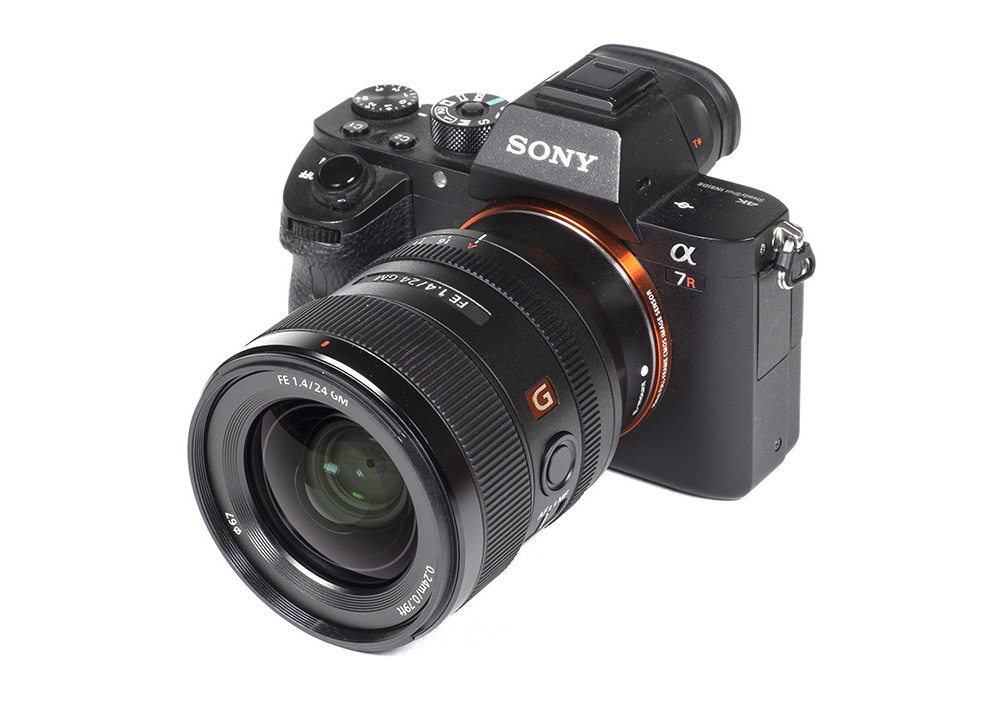by Klaus Schroiff, published October 2019
Introduction
Sony has enjoyed quite a headstart compared to Canon R/Nikon Z but obviously they keep on pushing. Lately, they have focused more and more on the professional (=high-margin) market segment. Part of this push is also the Sony FE 24mm f/1.4 GM. Regarding the recent trend of super-sizing every new lens design, you may expect that this is just another monstrosity, but this is not the case here. Sony managed to pack the ultra-large aperture into a size that is more aligned with the original ideas around mirrorless systems. As such they already gain sympathy points in our books just from a paper-spec perspective. Of course, such a fast lens is also part of Sony’s “G Master” (GM) series of professional-grade lenses – and the price tag of around 1600EUR/1400USD is reflecting this entitlement.
Despite the low weight (445g) and compact size (75.4×92.4mm), the build quality of the Sony lens is exceptional thanks to a tightly assembled combination of metal and high-quality plastic parts. Needless to say, the lens is both dust- and moisture resistant. The constant physical length also helps to keep the lens sealed. The focus ring operates smoothly. A specialty shared with a few other Sony FE lenses is the dedicated aperture ring which can be switched between a clicked-(for still life) and clickless-mode (for movies). If you set the aperture ring to A, you can, of course, continue to control the lens via the camera’s control dial. Following a Sony tradition, they also implemented a focus-hold button. A petal-shaped lens hood is part of the package.

Sony uses its DDSSM (Direct Drive SSM) for auto-focusing. It is both fast and essentially noiseless. While it continues to use a focus-by-wire system, it’s highly precise and you won’t really miss a directly-coupled system anymore. Sony is referring to this as Linear Response MF (or LR MF). Optical image stabilization is not provided, but you can, of course, take advantage of the in-camera OSS.
| Specifications | |
|---|---|
| Optical construction | 13 elements in 10 groups inc. 2xXA, 3xED elements |
| Number of aperture blades | 11 (rounded) |
| min. focus distance | 0.24m (max. magnification 1:5.9) |
| Dimensions | 75.4×92.4mm |
| Weight | 445g |
| Filter size | 67mm |
| Hood | petal-shaped (bayonet mount, supplied) |
| Other features | dust & moisture resistant, focus-hold button, aperture-ring, aperture click switch |
| Mount | Sony FE |
Distortion
Many “mirrorless” lenses aren’t fully corrected in terms of image distortions. However, Sony went the extra mile with the Sony FE 24mm f/1.4 GM. With a pincushion distortion of just under ~0.5%, there’s already nothing to complain about in RAW mode. The remaining traces can be eliminated in auto-correction mode.


Vignetting
Vignetting can be an issue in RAW mode and it is somewhat worse than usual in this lens class. At f/1.4 the light falloff is rather massive at 2.7EV (f-stops). Stopping down helps, of course, but the vignetting remains visible at around 1.5EV – probably a side effect of the rather small front element and an indication that Sony is relying on its image auto-correction capabilities in this respect. With activated auto-correction, you can still spot some light falloff at f/1.4 albeit it’s far from being extreme in this case. The issue is pretty much negligible by most standards from f/2.8 onward.

MTF (resolution)
The resolution characteristic is very impressive for such a fast lens. Typically f/1.4 lenses struggle at fully open aperture but the Sony lens manages to maintain a decent level of quality. The image center is dead sharp here and the near-center is very good. The borders/corners are, of course, softer but they don’t dive into a deep abyss at least. Stopping down to f/2 results in a general increase in quality and even the corners make it to good levels. It is worth noting that the center quality at f/2 is already exceeding the resolution of the 42mp sensor used for this test. The peak performance is reached around the f/4 mark with an outstanding center, an excellent broader center and a very good outer image region. Diffraction effects are starting to kick in at f/8 – albeit without limited impact. It’s getting more pronounced from f/11 onward though.
The field curvature is low. The centering quality of the tested sample was Ok.
Please note that the MTF results are not directly comparable across the different systems!
Below is a simplified summary of the formal findings. The chart shows line widths per picture height (LW/PH) which can be taken as a measure for sharpness. If you want to know more about the MTF50 figures you may check out the corresponding Imatest Explanations

Chromatic Aberrations (CAs)
On Sony cameras, you don’t really have to worry about chromatic aberrations due to image auto-correction. However, even if you prefer to disable this for whatever reason, the CAs are fairly low at around 1px on the average at the image borders.

Bokeh
Sony is stressing that the Sony FE 24mm f/1.4 GM isn’t just about excellent sharpness but it is also supposed to be capable of rendering a beautiful bokeh (out-of-focus blur). Generally, we agree with this – with one caveat.
When observing the focus transition zones, the bokeh is very smooth in the image background (shown to the left below). The less critical foreground blur (to the right) is rather harsh with double halos (nisen bokeh) though.

Out-of-focus highlights are almost perfect with a smooth inner zone and basically no outlining at the edges of the discs. The circular shape of the discs remains intact even when stopped down to f/2.8 – surely a positive impact from the 11 aperture blades.

Another positive surprise is the rendering of the highlight discs towards the borders/corners. Normally the shape of the discs deteriorates substantially – often into “cat eyes”. However, the Sony lens is -almost- capable of maintaining circular discs here (Note: you may notice some “highlight shadows” in the sample images below – these relate to the LED diodes with their non-perfect shape). As usual, stopping down corrects the shape a little.



Sample Images
Competition
There are probably two lenses that are competing with the Sony FE 24mm f/1.4 GM. The Zeiss Batis 25mm f/2 (center) may come into mind. Performance-wise it is probably in the same realm but it’s obviously one stop slower. It’s also a bit smaller/more light-weight and a bit more affordable. While directly comparable in terms of max. aperture, the Sigma 24mm f/1.4 DG HSM ART (to the right, with attached hood) is quite a brick thanks to its DSLR heritage. However, it’s substantially more affordable at just half the price.

Visual comparison courtesy of camerasize.com.
The Sony FE 24mm f/1.4 GM is the best lens in its class - at the time of this review at least. The resolution characteristic is highly impressive. The image center is already tack-sharp at f/1.4. The outer image field isn't quite on this level - it never is - but improves rapidly when stopping down a little. The results are very sharp across the image field from f/2.8 onward. Lateral CAs are fairly low and image distortions are nothing to worry about. The RAW vignetting is somewhat higher than it should be but then image auto-correction handles this issue nicely. Wide- to ultra-wide lenses tend to produce a rough bokeh due to their complex optical designs. However, Sony managed to produce a very smooth bokeh - at least with respect to the important image background. Thumps up for that!
Typical for Sony GM lenses, the build quality is superb and, of course, up to professional standards. The incorporated materials are of top-notch quality and it's a weather-sealed construction as well. If you like old school photography or are into movies, you will also appreciate the dedicated aperture ring - including an optional clickless mode. The AF is both very fast and near-silent. Manual focusing is exceptionally smooth and precise.
The sheer optical quality is already formidable but even more noteworthy is the fact that Sony managed to deliver all this in a comparatively small package. Especially Sigma improved their optical designs by lifting their constraints around the size/weight of their ART lenses. The Sony lens shows that this isn't really a necessity and we hope that the FE 24mm f/1.4 GM will not be the last in the line of compact, yet high performance lenses. Highly recommended!
-
Optical Quality
-
Build Quality
-
Price / Performance


